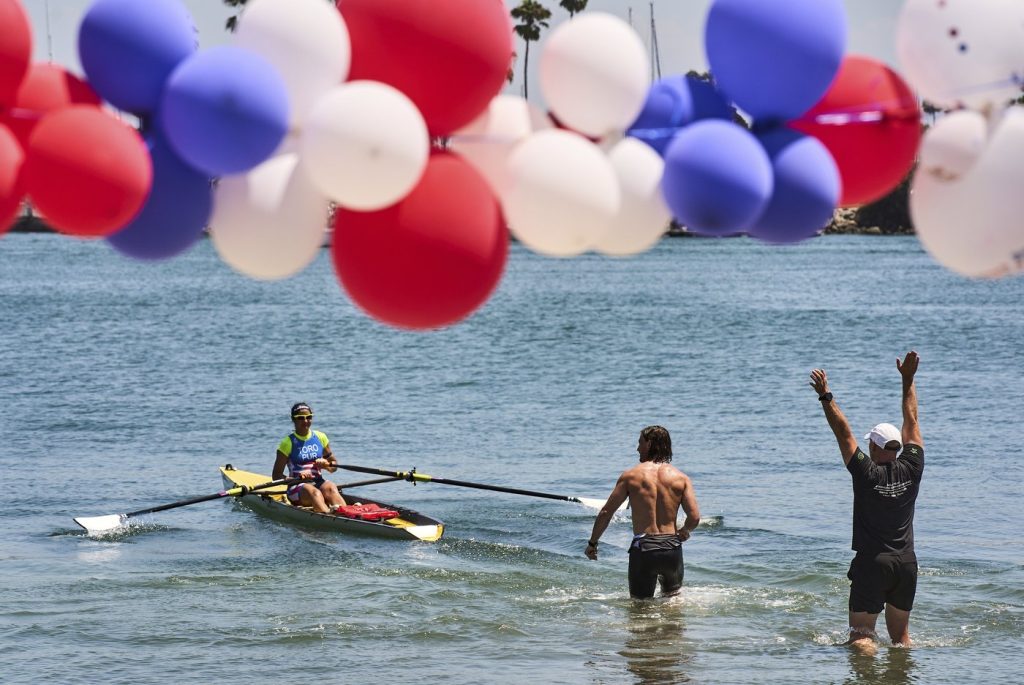LONG BEACH, Calif. (AP) – A unique blend of athleticism, speed, and entertainment is emerging as the beach sprint format is set to debut as an Olympic event in the upcoming 2028 Summer Games in Los Angeles. On a sunlit morning in Southern California, around twenty athletes gathered at a USRowing camp in Long Beach, the site of the inaugural Olympic races, to test their skills in beach sprints.
This new sporting discipline has garnered attention, especially among traditional flatwater rowers looking for exciting variations in their training. Participants engage in a fast-paced course where they sprint to the water, hop into a boat, navigate a slalom course, and rush back to shore, all in approximately three minutes. Each race features two competitors at a time, raising adrenaline levels and keeping spectators engaged.
“You don’t just have to be a good rower – you also have to be a good athlete,” stated Maurice Scott, a seasoned rower from Philadelphia who relocated to Long Beach specifically to train for the Olympics. He emphasized the need for adaptability in handling the dynamic conditions of coastal waters.
As the anticipation for the LA28 Olympics builds, interest in beach sprints surges, particularly as this format fills a gap left by the omission of the lightweight rowing category, which was favored by smaller athletes. According to rowing officials, beach sprints aim to create a spectator-friendly environment, moving the action closer to the audience where they can more easily follow the competition.
Guin Batten, chair of World Rowing's coastal commission, expressed excitement about having a lively atmosphere filled with music and cheering fans. She explained that the beach sprints format, developed over the last decade, offers a knockout-style race where any competitor could win until they cross the finish line. This unpredictability adds to the thrill of the event.
While some traditional rowers remain hesitant about the challenges posed by waves and wind, others have embraced the format. Christine Cavallo, a member of the U.S. national beach sprint team, highlighted the difficulties inherent in coastal rowing, stating, “You could be the best rower in the world and get flipped by the wave.” This inherent unpredictability adds an exhilarating layer to the sport.
The first major international competition for beach sprints took place at the 2015 Mediterranean Beach Games in Italy. More recently, the Head of the Charles, famous for its annual flatwater regatta in Massachusetts, experimented with beach sprints in July, attracting around 100 participants, double the expected turnout.
Since the Olympic announcement, training for beach sprints has intensified, with dedicated athletes starting to focus solely on the event. Marc Oria, the USA Beach Sprint head coach, remarked that training camps across Massachusetts, New Jersey, and Long Beach are actively encouraging veteran rowers and newcomers alike to try their hand at this exciting format. He noted that athletes find the requirement to be both agile and capable rowers to be invigorating.
At the Long Beach camp, participants ranged from an Olympic rower and a teacher to a marketing professional who just recently began rowing, demonstrating the sport's broad appeal. Bridgette Hanson, a 17-year-old from Arizona who raced in beach sprints for the first time, described her experience as requiring “a lot more brute force.”
John Wojtkiewicz, coach of the Long Beach Coastal Team, underscored the event's viewer-friendly nature. He expressed enthusiasm for the Olympic venue setup, hoping it will allow crowds to witness the entire race unfold, echoing the excitement found in surfing competitions.
Overall, beach sprints signify a growing movement in the rowing community, aiming to foster a more engaging and dynamic form of the sport leading up to the Los Angeles Olympics. With a mix of traditional rowing elements and a fresh, beachside approach, the anticipation for this event continues to build as athletes prepare for 2028.










